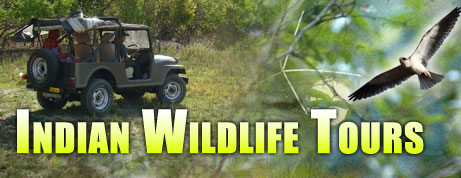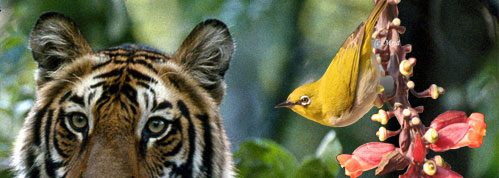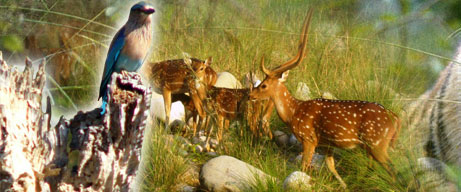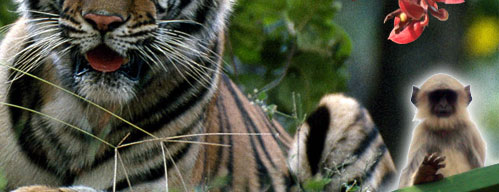Wild Species In India
Black
Buck
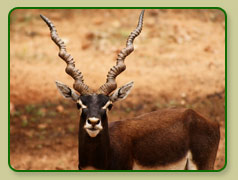 Kala
Hiran also called Indian Black Buck Antelope (Antelope cervicapra L.) is
an exclusively Indian animal, which is perhaps the most graceful and
beautiful of its kind. The Black Buck has four sub species, they are -
Antelope cervicapra cervicapra, Antelope cervicapra rajputanae, Antelope
cervicapra centralis, Antelope cervicapra rupicapra.
Kala
Hiran also called Indian Black Buck Antelope (Antelope cervicapra L.) is
an exclusively Indian animal, which is perhaps the most graceful and
beautiful of its kind. The Black Buck has four sub species, they are -
Antelope cervicapra cervicapra, Antelope cervicapra rajputanae, Antelope
cervicapra centralis, Antelope cervicapra rupicapra.
Biological Importance:
As other animal it is also a part of Nature and we need to conserve it for future generation. Black buck is one of 26 species of mammals, which have been declared endangered and protected by low in Nepal.
Economic Importance:
Each species has value and meaning. In present context Biodiversity richness is greater than monetary value.
Genetic Importance:
Cross breeding and development of high breed for domestic use.
Local Importance:
Tourist, researcher, animal lover may come tosee this important animal and it will help the diffusion of local culture or production to the external national or international visitor.
Reproduction:
Mating season is August to October and March to April. Male buck performs proud heads-up displays (nose up and horns parallel to the back) to attract the attention of female does. Male engages in rutting behavior throughout the whole year. The rut consists of fighting and sparring between males with their horns. The spiral shape of horns automatically locks the horns together so rarely do the animals get hurt. The bucks do this as a form of play as well as to assert dominance and breeding privileges.
Habitat:
They like to live in open grassland and dry thorn and scrubland. They like to be in herds about 20 to 30 individuals. A herd generally inhabits around 200 to 300 acres of land. A dominant male marks the territory by shifting and pawing the ground and urinating and defecating at established piles.
Food Habit:
Black buck are herbivore animals. They graze the soft grass and eat leaves, herbs and shrubs. The like to graze to vast area from the down to dust and take rest on shadow of the tree.
Features:
The keen eye sight and fast speed of Black Buck are its main protection against predators. When alarmed, the herd moves off in a series of high leaps and bounds, then breaks off into a quick gallop. It is one of the fastest animals in the world. The record shows that they can run 80 kilometer per hour if necessary.
 Kala
Hiran also called Indian Black Buck Antelope (Antelope cervicapra L.) is
an exclusively Indian animal, which is perhaps the most graceful and
beautiful of its kind. The Black Buck has four sub species, they are -
Antelope cervicapra cervicapra, Antelope cervicapra rajputanae, Antelope
cervicapra centralis, Antelope cervicapra rupicapra.
Kala
Hiran also called Indian Black Buck Antelope (Antelope cervicapra L.) is
an exclusively Indian animal, which is perhaps the most graceful and
beautiful of its kind. The Black Buck has four sub species, they are -
Antelope cervicapra cervicapra, Antelope cervicapra rajputanae, Antelope
cervicapra centralis, Antelope cervicapra rupicapra.Biological Importance:
As other animal it is also a part of Nature and we need to conserve it for future generation. Black buck is one of 26 species of mammals, which have been declared endangered and protected by low in Nepal.
Economic Importance:
Each species has value and meaning. In present context Biodiversity richness is greater than monetary value.
Genetic Importance:
Cross breeding and development of high breed for domestic use.
Local Importance:
Tourist, researcher, animal lover may come tosee this important animal and it will help the diffusion of local culture or production to the external national or international visitor.
Reproduction:
Mating season is August to October and March to April. Male buck performs proud heads-up displays (nose up and horns parallel to the back) to attract the attention of female does. Male engages in rutting behavior throughout the whole year. The rut consists of fighting and sparring between males with their horns. The spiral shape of horns automatically locks the horns together so rarely do the animals get hurt. The bucks do this as a form of play as well as to assert dominance and breeding privileges.
Habitat:
They like to live in open grassland and dry thorn and scrubland. They like to be in herds about 20 to 30 individuals. A herd generally inhabits around 200 to 300 acres of land. A dominant male marks the territory by shifting and pawing the ground and urinating and defecating at established piles.
Food Habit:
Black buck are herbivore animals. They graze the soft grass and eat leaves, herbs and shrubs. The like to graze to vast area from the down to dust and take rest on shadow of the tree.
Features:
The keen eye sight and fast speed of Black Buck are its main protection against predators. When alarmed, the herd moves off in a series of high leaps and bounds, then breaks off into a quick gallop. It is one of the fastest animals in the world. The record shows that they can run 80 kilometer per hour if necessary.
